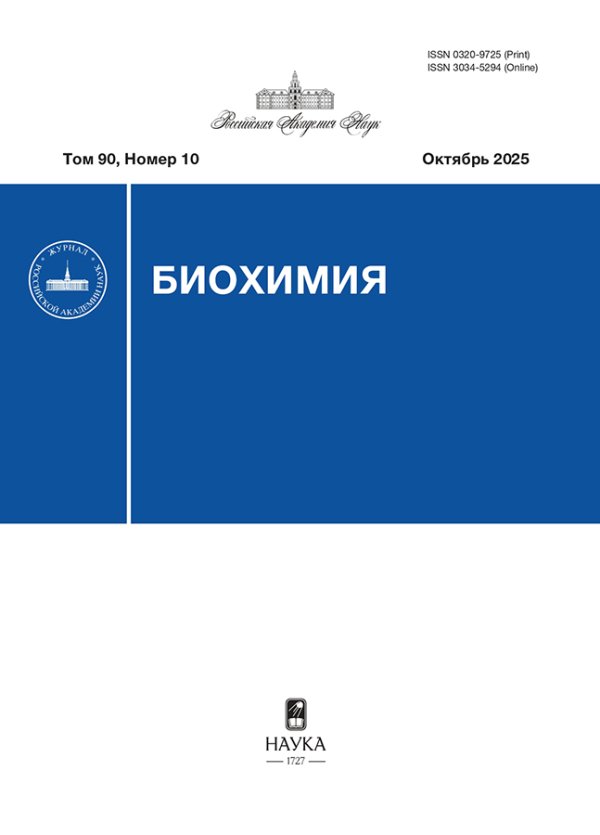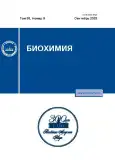Создание системы гетерологичной экспрессии и оптимизация способа наработки β-субъединицы холерного токсина в клетках E. coli
- Авторы: Жамгочян Х.Х1, Замахаев М.В1, Случанко Н.Н1, Гончаренко А.В1, Шумков М.С1
-
Учреждения:
- ФИЦ Биотехнологии РАН, Институт биохимии им. А.Н. Баха
- Выпуск: Том 88, № 9 (2023)
- Страницы: 1581-1596
- Раздел: Статьи
- URL: https://journals.rcsi.science/0320-9725/article/view/141489
- DOI: https://doi.org/10.31857/S0320972523090105
- EDN: https://elibrary.ru/WYVGMK
- ID: 141489
Цитировать
Полный текст
Аннотация
Ключевые слова
Об авторах
Х. Х Жамгочян
ФИЦ Биотехнологии РАН, Институт биохимии им. А.Н. Баха119071 Москва, Россия
М. В Замахаев
ФИЦ Биотехнологии РАН, Институт биохимии им. А.Н. Баха119071 Москва, Россия
Н. Н Случанко
ФИЦ Биотехнологии РАН, Институт биохимии им. А.Н. Баха119071 Москва, Россия
А. В Гончаренко
ФИЦ Биотехнологии РАН, Институт биохимии им. А.Н. Баха
Email: pylaevanna@gmail.com
119071 Москва, Россия
М. С Шумков
ФИЦ Биотехнологии РАН, Институт биохимии им. А.Н. Баха119071 Москва, Россия
Список литературы
- Almagro-Moreno, S., and Taylor, R. K. (2013) Cholera: environmental reservoirs and impact on disease transmission, Microbiol. Spectr., 1, doi: 10.1128/microbiolspec.OH-0003-2012.
- Hu, D., Liu, B., Feng, L., Ding, P., Guo, X., Wang, M., Cao, B., Reeves, P. R., and Wang, L. (2016) Origins of the current seventh cholera pandemic, Proc. Natl. Acad. Sci. USA, 113, E7730-E7739, doi: 10.1073/pnas.1608732113.
- WHO. TheWeekly Epidemiological Record (2021) URL: www.who.int/publications/journals/weeklyepidemiological-record (дата обращения: 18.08.2023).
- Всемирная организация здравоохранения (11 февраля 2023 г.). Новости о вспышках болезней. Холера - ситуация в мире, URL: www.who.int/ru/emergencies/disease-outbreak-news/item/2023-DON437 (дата обращения: 18.08.2023).
- Clemens, J., Shin, S., Sur, D., Nair, G. B., and Holmgren, J. (2011) New-generation vaccines against cholera, Nat. Rev. Gastroenterol. Hepatol., 8, 701-710. doi: 10.1038/nrgastro.2011.174.
- Hui Xian, T., Parasuraman, S., Ravichandran, M., and Prabhakaran, G. (2022) Dual-use vaccine for diarrhoeal diseases: cross-protective immunogenicity of a cold-chain-free, live-attenuated, oral cholera vaccine against enterotoxigenic Escherichia coli (ETEC) challenge in BALB/c mice, Vaccines, 10, 2161, doi: 10.3390/vaccines10122161.
- WHO. Cholera vaccine, URL: www.who.int/teams/immunization-vaccines-and-biologicals/diseases/cholera (дата обращения: 18.08.2023).
- Ravichandran, M., Tew, H. X., Prabhakaran, G., Parasuraman, S., and Norazmi, M. N. (2022) Live, genetically attenuated, cold-chain-free cholera vaccine - a research and development journey: light at the end of a long tunnel, Malays. J. Med. Sci., 29, 1-7, doi: 10.21315/mjms2022.29.2.1.
- Sumarokov, A. A., Ivanov, N. R., Dzhaparidze, M. N., Rystsova, E. A., Reznikov, Iu. B., et al. (1991) The characteristics of the reactogenicity and immunological activity of a new cholera bivalent chemical vaccine based on the results of controlled trials, Zhurn. Mikrobiol. Epidemiol. Immunobiol., 7, 55-58.
- Sumarokov, A. A., Dzhaparidze, M. N., Eliseev, Iu. Iu., Nikitina, G. P., Poliakov, K. A., et al. (1993) The determination of the optimal inoculation dose of an oral cholera bivalent chemical vaccine in a controlled trial of the vaccination of children and adolescents, Zhurn. Mikrobiol. Epidemiol. Immunobiol., 5, 55-60.
- Вакцина холерная бивалентная химическая, инструкция по применению, URL: www.vidal.ru/drugs/cholera_bivalent_chemical_vaccine__42897 (дата обращения: 18.08.2023).
- Zhang, R. G., Westbrook, M. L., Westbrook, E. M., Scott, D. L., and Otwinowski, Z. (1995) The 2.4 A crystal structure of cholera toxin B subunit pentamer: choleragenoid, J. Mol. Biol., 251, 550-562, doi: 10.1006/jmbi.1995.0455.
- Korotkov, K. V., Sandkvist, M., and Hol, W. G. (2012) The type II secretion system: biogenesis, molecular architecture and mechanism, Nat. Rev. Microbiol., 10, 336-351, doi: 10.1038/nrmicro2762.
- Overbye, L. J., Sandkvist, M., and Bagdasarian, M. (1993) Genes required for extracellular secretion of enterotoxin are clustered in Vibrio cholerae, Gene, 132, 101-106, doi: 10.1016/0378-1119(93)90520-D.
- Wernick, N. L., Chinnapen, D. J., Cho, J. A., and Lencer, W. I. (2010) Cholera toxin: an intracellular journey into the cytosol by way of the endoplasmic reticulum, Toxins (Basel), 2, 310-325, doi: 10.3390/toxins2030310.
- Baldauf, K. J., Royal, J. M., Hamorsky, K. T., and Matoba, N. (2015) Cholera toxin B: one subunit with many pharmaceutical applications., Toxins (Basel), 7, 974-996, doi: 10.3390/toxins7030974.
- Jelinek, T., and Kollaritsch, H. (2008) Vaccination with Dukoral against travelers' diarrhea (ETEC) and cholera, Expert Rev. Vaccines, 7, 561-567, doi: 10.1586/14760584.7.5.561.
- Lebens, M., Johansson, S., Osek, J., Lindblad, M., and Holmgren, J. (1993) Large-scale production of Vibrio cholerae toxin B subunit for use in oral vaccines, Biotechnology, 11, 1574-1578, doi: 10.1038/nbt1293-1574.
- Rhie, G. E., Jung, H. M., Park, J., Kim, B. S., and Mekalanos, J. J. (2008) Construction of cholera toxin B subunit-producing Vibrio cholerae strains using the Mariner-FRT transposon delivery system, FEMS Immunol. Med. Microbiol., 52, 23-28, doi: 10.1111/j.1574-695X.2007.00346.x.
- Slos, P., Dutot, P., Reymund, J., Kleinpeter, P., and Prozzi, D. (1998) Production of cholera toxin B subunit in Lactobacillus, FEMS Microbiol. Lett., 169, 29-36, doi: 10.1111/j.1574-6968.1998.tb13295.x.
- Goto, N., Maeyama, J., Yasuda, Y., Isaka, M., and Matano, K. (2000) Safety evaluation of recombinant cholera toxin B subunit produced by Bacillus brevis as a mucosal adjuvant, Vaccine, 18, 2164-2171, doi: 10.1016/s0264-410x(99)00337-0.
- Zeighami, H., Sattari, M., and Rezayat, M. (2010) Cloning and expression of a cholera toxin beta subunit in Escherichia coli, Ann. Microbiol., 60, 451-454, doi: 10.1007/s13213-010-0062-z.
- Dakterzada, F., Mobarez, A. M., Roudkenar, M. H., and Forouzandeh, M. (2012) Production of pentameric cholera toxin B subunit in Escherichia coli, Avicenna J. Med. Biotechnol., 4, 89-94.
- Slos, P., Speck, D., Accart, N., Kolbe, H. V., and Schubnel, D. (1994) Recombinant cholera toxin B subunit in Escherichia coli: high-level secretion, purification, and characterization, Protein Expr. Purif., 5, 518-526, doi: 10.1006/prep.1994.1071.
- Matoba, N. (2015) N-glycosylation of CHOLERA toxin B subunit: serendipity for novel plant-made vaccines? Front Plant Sci., 6, 1132, doi: 10.3389/fpls.2015.01132.
- Hamorsky, K. T., Kouokam, J. C., Bennett, L. J., Baldauf, K. J., and Kajiura, H. (2013) Rapid and scalable plant-based production of a cholera toxin B subunit variant to aid in mass vaccination against cholera outbreaks, PLoS Negl. Trop. Dis., 7, e2046, doi: 10.1371/journal.pntd.0002046.
- Mudrak, B., and Kuehn, M. J. (2010) Specificity of the type II secretion systems of enterotoxigenic Escherichia coli and Vibrio cholerae for heat-labile enterotoxin and cholera toxin, J. Bacteriol., 192, 1902-1911, doi: 10.1128/JB.01542-09.
- Strain - DH5α. The Coli Genetic Stock Center (CGSC). Yale University, URL: https://cgsc.biology.yale.edu/Strain.php?ID=150015 (дата обращения: 18.08.2023).
- Karpov, D. S., Goncharenko, A. V., Usachev, E. V., Vasina, D. V., Divisenko, E. V., Chalenko, Y. M., Pochtovyi, A. A., Ovchinnikov, R. S., Makarov, V. V., Yudin, S. M., Tkachuk, A. P., and Gushchin, V. A. (2021) A strategy for the rapid development of a safe Vibrio cholerae candidate vaccine strain, Int. J. Mol. Sci., 22, 11657, doi: 10.3390/ijms222111657.
- Quan, S., Hiniker, A., Collet, J. F., and Bardwell, J. C. (2013) Isolation of bacteria envelope proteins, Methods Mol. Biol., 966, 359-366, doi: 10.1007/978-1-62703-245-2_22.
- Laemmli, U. K. (1970) Cleavage of structural proteins during the assembly of the head of bacteriophage T4, Nature, 227, 680-685, doi: 10.1038/227680a0.
- Brunelle, J. L., and Green, R. (2014) One-dimensional SDS-polyacrylamide gel electrophoresis (1D SDS-PAGE), Methods Enzymol., 541, 151-159, doi: 10.1016/B978-0-12-420119-4.00012-4.
- GelAnalyzer 19.1, URL: www.gelanalyzer.com (дата обращения: 18.08.2023).
- Hamorsky, K., and Matoba, N. (2016) Facile method for the production of recombinant cholera toxin B subunit in E. coli, Methods Mol. Biol., 1404, 511-518, doi: 10.1007/978-1-4939-3389-1_33.
- Naha, A., Mandal, R. S., Samanta, P., Saha, R. N., and Shaw, S. (2020) Deciphering the possible role of ctxB7 allele on higher production of cholera toxin by Haitian variant Vibrio cholerae O1, PLoS Negl. Trop. Dis., 14, e0008128, doi: 10.1371/journal.pntd.0008128.
- Wang, Y. (2002) The function of OmpA in Escherichia coli, Biochem. Biophys. Res. Commun., 292, 396-401, doi: 10.1006/bbrc.2002.6657.
- Keen, N. T., and Tamaki, S. (1986) Structure of two pectate lyase genes from Erwinia chrysanthemi EC16 and their high-level expression in Escherichia coli, J. Bacteriol., 168, 595-606, doi: 10.1128/jb.168.2.595-606.1986.
- Lei, S. P., Lin, H. C., Wang, S. S., Callaway, J., and Wilcox, G. (1987) Characterization of the Erwinia carotovora pelB gene and its product pectate lyase, J. Bacteriol., 169, 4379-4383, doi: 10.1128/jb.169.9.4379-4383.1987.
- Ruppert, A., Arnold, N., and Hobom, G. (1994) OmpA-FMDV VP1 fusion proteins: production, cell surface exposure and immune responses to the major antigenic domain of foot-and-mouth disease virus, Vaccine, 12, 492-498, doi: 10.1016/0264-410x(94)90305-0.
- Low, K. O., Mahadi M. N., and Illias R. M. (2013) Optimisation of signal peptide for recombinant protein secretion in bacterial hosts, Appl. Microbiol. Biotechnol., 97, 3811-3826, doi: 10.1007/s00253-013-4831-z.
- Zhou, Y., Lu, Z., Wang, X., Selvaraj, J. N., and Zhang, G. (2018) Genetic engineering modification and fermentation optimization for extracellular production of recombinant proteins using Escherichia coli, Appl. Microbiol. Biotechnol., 102, 1545-1556, doi: 10.1007/s00253-017-8700-z.
- Lee, J. H., Choi, S. Y., Jeon, Y. S., Lee, H. R., and Kim, E. J. (2009) Classification of hybrid and altered Vibrio cholerae strains by CTX prophage and RS1 element structure, J. Microbiol., 47, 783-788, doi: 10.1007/s12275-009-0292-6.
- Dertzbaugh, M. T., and Cox, L. M. (1998) The affinity of cholera toxin for Ni2+ ion, Protein Eng., 11, 577-581, doi: 10.1093/protein/11.7.577.
- Zhu, P., Stanisheuski, S., Franklin, R., Vogel, A., Vesely, C. H., Reardon, P., Sluchanko, N. N., Beckman, J. S., Karplus, P. A., Mehl, R. A., and Cooley, R. B. (2023) Autonomous synthesis of functional, permanently phosphorylated proteins for defining the interactome of monomeric 14-3-3ζ, ACS Cent Sci., 9, 816-835, doi: 10.1021/acscentsci.3c00191.
- Shatov, V. M., Muranova, L. K., Zamotina, M. A., Sluchanko, N. N., and Gusev, N. B. (2023) α-Crystallin domains of five human small heat shock proteins (sHsps) differ in dimer stabilities and ability to incorporate themselves into oligomers of full-length sHsps, Int. J. Mol. Sci., 24, 1085, doi: 10.3390/ijms24021085.
- Slonimskiy, Y. B., Zupnik, A. O., Varfolomeeva, L. A., Boyko, K. M., Maksimov, E. G., and Sluchanko, N. N. (2022) A primordial orange carotenoid protein: structure, photoswitching activity and evolutionary aspects, Int. J. Biol. Macromol., 222, 167-180, doi: 10.1016/j.ijbiomac.2022.09.131.
- Янишевский Н. В., Гинцбург А. Л., Вертиев Ю. В., Демме Ю. М., Каратаев Г. И. (1987) Конструирование рекомбинантных плазмид, кодирующих биосинтез β-субъединицы холерного токсина, Мол. Генет., 4.
- Смирнова Н. И., Чеховская Г. В., Ливанова Л. Ф., Кобкова И. М. (2004) Штамм бактерий Escherichia coli КМ 147 - продуцент β-субъединицы холерного токсина, Патент на изобретение № 2238975.
Дополнительные файлы










